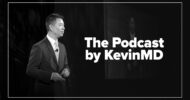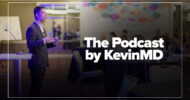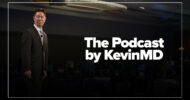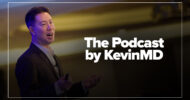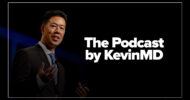Subscribe to The Podcast by KevinMD. Watch on YouTube. Catch up on old episodes!
Health care executive Traci Sweet discusses her article, “The role of contingency management in addiction treatment.” She makes a compelling case for the increased use of contingency management—an evidence-based approach utilizing positive reinforcement—to improve outcomes for individuals with substance use disorder (SUD). Traci explains how this method, which rewards positive behaviors like treatment engagement, can effectively leverage the brain’s reward system and is particularly beneficial given the high relapse rates associated with traditional treatments. The conversation explores practical applications of contingency management, including app-based digital incentive programs, and highlights its success in her own practice. Traci also outlines a broader vision for the future of SUD care, emphasizing the need to embrace innovation, technology such as AI and digital therapeutics, emerging pharmacological treatments like GLP-1 agonists and psychedelic-assisted therapy, and holistic interventions to create more personalized and effective recovery pathways. The key takeaway is: To address the ongoing addiction crisis, the health care system must move beyond one-size-fits-all models and actively integrate innovative, evidence-based strategies like contingency management alongside cutting-edge technologies and a wider range of therapeutic options.
Our presenting sponsor is Microsoft Dragon Copilot.
Microsoft Dragon Copilot, your AI assistant for clinical workflow, is transforming how clinicians work. Now you can streamline and customize documentation, surface information right at the point of care, and automate tasks with just a click.
Part of Microsoft Cloud for Healthcare, Dragon Copilot offers an extensible AI workspace and a single, integrated platform to help unlock new levels of efficiency. Plus, it’s backed by a proven track record and decades of clinical expertise—and it’s built on a foundation of trust.
It’s time to ease your administrative burdens and stay focused on what matters most with Dragon Copilot, your AI assistant for clinical workflow.
VISIT SPONSOR → https://aka.ms/kevinmd
SUBSCRIBE TO THE PODCAST → https://www.kevinmd.com/podcast
RECOMMENDED BY KEVINMD → https://www.kevinmd.com/recommended
Transcript
Kevin Pho: Hi, and welcome to the show. Subscribe at KevinMD.com/podcast. Today we welcome Traci Sweet. She’s a health care executive. Today’s KevinMD article is “The role of contingency management in addiction treatment.” Traci, welcome to the show.
Traci Sweet: Thank you so much, Kevin. Glad to be here.
Kevin Pho: All right, so tell us a little about your story and then tell us about the events that led you to write this KevinMD article.
Traci Sweet: I’ve been in the behavioral health and addiction treatment space for more than 30 years now. The industry has led me; I practiced clinically as a doctor of clinical psychology for a number of years and went into administration at the end of 2016, having paid my dues in inpatient and outpatient practice, et cetera.
What I’ve learned since those years of going into administration and now working with providers and coaching and teaching providers is that we have an opportunity, particularly in 2025, to shed additional light and learn more about the way to treat people, from bedside manner to innovation, to the use of AI, to the use of technology to help more people be successful.
In 2023, I joined my business partner, Jason, and we started Holon Health. The reason that we started Holon was because we saw this opportunity to add innovation that filled gaps in treatment. We’ve been talking about cognitive behavioral therapy and medication-assisted treatment therapy for years and years, and yet we’re still not winning the war. We’re still not winning that battle and helping more people be successful in recovery. Whether it’s in the criminal justice space or the everyday person space, the numbers are abysmal.
We have an opportunity to look at things through a different lens. Being an innovator and someone who is progressive and forward-thinking clinically, it was my chance to put that forward. That’s how we came up with contingency management and adding that to positive psychology and solution-focused therapy to develop our program.
Kevin Pho: All right, so tell us a little bit about some of the gaps that you mentioned when it comes to substance use disorder, and then talk about how some of your approaches can fill those gaps. So, what are those gaps?
Traci Sweet: If you think about just traditional health care, we don’t go to the doctor thinking that it’s a negative experience. We want it to be a positive experience. From when we were little, you go to the doctor, and they either give you a shot or you get a lollipop. If you got a lollipop, you would want to go to the doctor. Instead, you get shots. When you’re young, your mother says you’ve got to go to the doctor, and you say, “Oh my gosh, am I going to get a shot?” It’s that negative experience that keeps you from wanting to go back. That’s traditional treatment.
Even as adults, we go to the doctor, and they say, “Your A1C is high, your cholesterol is bad. You’ve got to do X, Y, and Z. You’ve got to lose 30 pounds. You’ve got to exercise.” It’s negative, negative, negative.
Imagine going to the doctor and having them say, “You’re doing great, and things have improved. Here are some other suggestions, but I want you to keep doing more of this and keep doing more of this,” and ignoring the negative noise. Then you would want to continue.
If we do that in substance use disorder treatment, would more people be willing to engage? Would the stigma be less? Would we show less judgment as providers? The answer to all those questions is yes. So in our practice, when we find people coming in who are voluntarily coming because they need help, the things that we should not do with them are: we should not shame them, we should not judge them, and we should not ask them to go back and revisit their history, their trauma, or have to tell their story of how they ended up here. Yet that is what we do. We take them back in an attempt to take them forward.
Positive psychology says, “OK, you’re here. I understand you have a problem. Where do you want to go? What do you want to do with the rest of your life? What are your goals, and how can I help you get there?”
We’ve been treating thousands of patients at Holon Health. When we say those things to people, they are immediately taken aback. “You don’t want to hear about X, Y, and Z?” No. Today’s the first day of the rest of your life. Where do you want to go? I’m not as concerned with what’s in the rearview mirror. I want to help you move forward and, as such, reward your successes going forward.
The way to do that is via positive psychology and the use of contingency management. That’s where my article came from: understanding that basic positive reinforcement works; punishment, negativity, and judgment do not. And that’s how it came to be.
Kevin Pho: So when it comes specifically to substance use disorder, give us some examples. You had a case study in your article about how positive psychology and contingency management play out in action. What does that look like?
Traci Sweet: At Holon Health, we work almost predominantly with the criminal justice system, with the intersection of criminal justice and health care. So many people are referred to us from their probation officers. They are coming out of incarceration. They need help and services, but they have been traditionally shamed and judged by providers, so they have a very negative opinion of us as doctors, MDs, and NPs.
Kevin Pho: When you say that they’re shamed by their clinicians, what does that look like? What’s said to them?
Traci Sweet: It’s not even just their clinicians; it’s their family members saying, “Why can’t you just stop? Why did you have to get into this? Why did you steal from me? You’re horrible. This is awful. You’re hurting me; you’re hurting your family.” Those are the things that they’re hearing over and over and over again. There’s the shot. There’s not the lollipop.
So when they come to us, they’re reluctant to engage. They have a negative view of us as people who are going to perpetuate that pattern in their lives, who are going to judge and shame. And we don’t. We treat them differently. They’re immediately at ease knowing that we’re not going to ask them to repeat their stories. We’re not going to tell them how horrible they are. We’re all one bad decision away. We really are.
Then we use contingency management to reinforce the fact that they even showed up, that you came and stayed with me for 30 minutes, that you answered my questions. From there, we develop a treatment plan with their goals in mind, not my goals.
For example, we have worked with a number of people who are unhoused, who have been homeless, and who are living in tents. Normally, many providers would say, “Well then, we need to get you housing.”
When that’s been said to some of our clients, they said, “No, that’s my family. That’s my social circle. I’m content being unhoused. These people are my backbone. They’re my friends. I don’t want to move out of my car. I’m happy there.” So for us to put our goals on a person is just not acceptable to me. What do you want to do? If you’re comfortable being unhoused, how can I help you? What do you want to do?
It allows them to have some executive decision-making over their own lives, to take responsibility and be accountable for where their lives are going. For us, I think of it in terms of a mother duck. We just get to move you and try to keep you on track and support your walking and support your flying.
Doing that, allowing them to have incremental goals as we develop that treatment plan and then positively reinforcing their small achievements cumulatively, we find that there’s a transition moment where that reluctance to engage suddenly becomes an opportunity for them to get more lollipops and less injections. They now want to engage because it’s positively reinforcing. It’s replacing the dopamine hit that they used to get from drugs with a wellness and a preventative medicine perspective and something that genuinely makes them happy: feeling success. It’s that same dopamine hit given in a positive way.
Kevin Pho: For those who aren’t familiar with the term contingency management, what exactly is that?
Traci Sweet: Contingency management is old-school. It is receiving a reward. Sometimes it’s an item; it might be a raffle ticket or some other reinforcement that is a reward for doing something that we would consider pro-social or good behavior. For those of us that have children, I’m a mom. I used to give my son a dollar for making his bed, and he would get a star on his chart. That’s essentially the same principle as contingency management. It goes back to Pavlov and the dogs and conditional and operant conditioning and reinforcement.
Kevin Pho: You mentioned that a lot of your clients got the shot, right? They’re continuously exposed to negative reinforcement, just negative language. Then when they go and utilize your services, they have a more positive approach: positive psychology, contingency management, and then they eventually have that transition point, as you said. How long does it take? I know everyone’s different, but in general, how long does it take before they have that transition point after being exposed to perhaps years of negativity?
Traci Sweet: That’s a loaded question. Extinguishing behavior sometimes takes a really long time, even with a perfect plan. Contingency management itself is meant to last four to six months. It’s a short-term intervention that we hope to titrate down, and we’ve seen that to be consistently pretty accurate. Some people adapt to it very quickly. They’re immediately engaged with our digital therapeutic app. They’re immediately engaged with their providers. They’re earning small, I mean small, incremental 10- and 25-cent rewards that are so meaningful. It’s not about the dollar value; it’s about the dopamine and that positive experience.
But generally, four to six months is when we start to pull back a little bit. They’re not necessarily getting as many rewards for smaller things; they’re now getting them for the bigger things. The Biden administration increasing the cap on what we could offer in terms of rewards as contingency management did help us titrate that. But generally, we think four to six months for people to establish a behavior that then becomes rote.
Take going to AA. They’re reluctant to go to AA. Over the course of time, they meet a sponsor, they make a new social circle, and now they want to go to AA to see people that they enjoy being around or that support them naturally. It’s less about getting rewarded for going to the meeting; it’s more about, “I want to go to this meeting because I get to see so-and-so.”
Kevin Pho: So give us a case study. It could be real or hypothetical about how some of these rewards can really change that behavior. What would some of these practices look like in real life?
Traci Sweet: The best way to implement something like contingency management—and it’s evidence-based, has been around for an awfully long time, but it’s been difficult to implement traditionally, at least to maintain—is through the use of a digital therapeutic application that allows people to earn rewards. It’s easy to replicate and easy to deliver.
For example, someone logs into the app, they complete some psychoeducational lessons—they do two a day—they get a positive affirmation, and they get a monetary reward just for logging into the app. By the end of day one, they’ve earned a dollar fifty. Every day that accumulates for Holon Health, they’re able to withdraw that money onto their debit card, and then that reward gets exponentially larger and to a larger audience.
Now, for a husband who has Mother’s Day this weekend and wants to do something nice for the mother of his children, he’s got 35 bucks on his debit card that he can use to take the kids out to Chuck E. Cheese. There’s that sense of, “I’m doing something really good with my life.” He’s able to take his wife, and now it’s not just our client, who is the dad in the situation, the husband, but he has also had a positive impact on his family. He then hears that reinforcement coming from his kids and his wife. So it just grows exponentially and really leads him to having some self-fulfilling positivity in his life.
Kevin Pho: And who funds these programs? Who funds these rewards? You mentioned the Biden administration. Is this a government-funded program? Tell me about that.
Traci Sweet: The Office of the Inspector General has put out letters that say contingency management is a particularly effective intervention for people with SUD, particularly for methamphetamine and cocaine users where there is no medication-assisted treatment. In cases where there is medication-assisted treatment, it’s a great augment. We’re funding this through Medicaid dollars, through remote therapeutic monitoring, and through our own reimbursement rates for our other services.
Holon Health, as a hybrid model, has the digital therapeutic application but also has providers that are providing standard telehealth services, whether for counseling, peer recovery services, or E&M codes for traditional PCP-like care as a transition to community-based.
We take care of that out of our return on investments that we do with the clients. It’s up to $50 a month. They have the ability to earn about $500 a year. It’s supported by our government, which is great, and it allows us to offer it.
Kevin Pho: We’re talking to Traci Sweet. She’s a health care executive. Today’s KevinMD article is “The role of contingency management in addiction treatment.” Traci, let’s end with some take-home messages you want to leave with the KevinMD audience.
Traci Sweet: If you are a provider and you’re looking to add some innovation and augments to traditional therapy, or an independent provider association that is struggling to deal with people who are struggling with addiction and substance use disorder, think about partnering with an organization such as Holon Health that can add adjunctive therapies in ways that you may not want to. Community-based mental health providers: we don’t want to replace them. We want to help them treat more people and augment services that they may struggle to deliver by using a digital therapeutic and more innovation. We’re here, and please check us out on holonhealth.com and, of course, on KevinMD for the article that I wrote on contingency management. We’re happy to help.
Kevin Pho: Traci, thank you so much for sharing your perspective and insight, and thanks again for coming on the show.
Traci Sweet: My pleasure, Kevin. Thanks so much.









